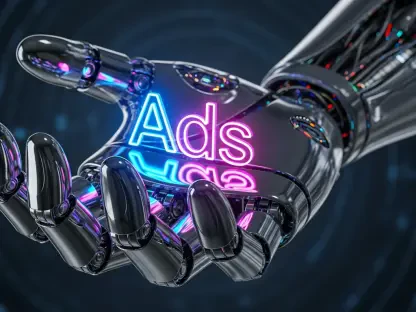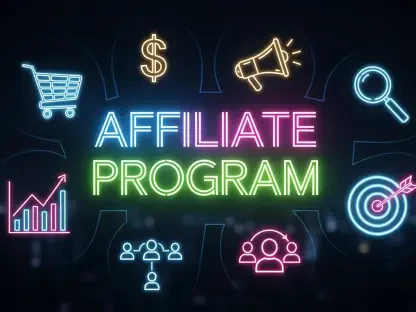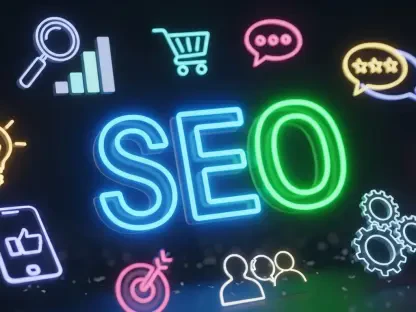The digital advertising industry stands at a transformative crossroads, where the sheer volume of data and the complexity of multi-channel campaigns have pushed traditional methods to their limits, demanding innovative solutions. With global spending on digital ads surpassing hundreds of billions annually, the pressure to deliver precise, scalable, and personalized content has never been higher, and this dynamic landscape is being reshaped by artificial intelligence (AI) and automation. These technologies promise to redefine efficiency and creativity in advertising. As agencies grapple with escalating demands, the integration of these tools offers a glimpse into a future where operational challenges are met with innovative solutions, setting the stage for a deeper exploration of their impact.
The Current Landscape of Digital Advertising
Digital advertising has emerged as a cornerstone of the global economy, driving brand visibility and consumer engagement across diverse platforms. Its rapid growth reflects a shift in marketing budgets toward online channels, with businesses prioritizing measurable outcomes and real-time interactions. This sector encompasses a vast ecosystem, from search engine marketing to video ads, underpinning the way companies connect with audiences in an increasingly connected world.
Key segments like display ads, social media advertising, and programmatic buying dominate the market, each catering to specific consumer touchpoints. Display ads capture attention through visual placements on websites, while social media advertising leverages platforms like Instagram and LinkedIn for targeted outreach. Programmatic buying, fueled by automated bidding systems, streamlines ad placement, ensuring efficiency in reaching the right viewers at optimal times.
Technological advancements further shape this arena, with data-driven campaigns and multi-channel strategies becoming standard practice. The ability to analyze consumer behavior through vast datasets allows for precise targeting, while cross-platform approaches ensure consistent messaging. Major players, including leading agencies, tech giants, and specialized platforms, compete fiercely, driving innovation while navigating a landscape influenced by regulations such as GDPR and CCPA, which enforce strict data privacy standards and reshape operational norms.
The Impact of AI and Automation on Advertising
Emerging Trends and Technological Advancements
The adoption of AI and automation marks a pivotal shift in digital advertising, addressing long-standing challenges with cutting-edge solutions. Technologies like robotic process automation (RPA) handle repetitive tasks such as campaign setup, while intelligent automation (IA) integrates cognitive capabilities for more complex functions. This synergy is transforming how agencies operate, enabling them to manage intricate, omnichannel campaigns with unprecedented ease.
Scalability, once a significant hurdle, is now within reach as these tools streamline workflows across diverse platforms. Automation reduces manual workload, allowing teams to oversee vast ad inventories without proportional increases in resources. Meanwhile, AI tailors content to individual preferences, meeting consumer demand for personalized experiences through dynamic messaging and real-time adjustments.
This technological wave also opens new avenues for agencies to prioritize strategic creativity over mundane operations. By automating routine processes, professionals can focus on crafting innovative campaigns and building stronger client relationships. The result is a redefined industry focus, where efficiency and imagination coexist, paving the way for more impactful advertising efforts.
Market Growth and Future Projections
The digital advertising market continues to expand, with current estimates placing its value in the hundreds of billions, fueled significantly by AI and automation adoption. Recent data highlights a surge in investment toward these technologies, correlating with improved campaign performance metrics like reduced costs and higher return on investment. Such indicators underscore the tangible benefits of integrating advanced systems into advertising workflows.
Looking ahead, forecasts from this year to 2027 suggest a steady rise in AI-driven solutions, projecting substantial market growth as more firms embrace these tools. Innovations in predictive analytics and automated optimization are expected to further enhance campaign outcomes, pushing the boundaries of what digital advertising can achieve. This trajectory points to a future where technology is integral to every facet of the industry.
Automation is also poised to redefine operational models, shifting the focus from labor-intensive processes to streamlined, tech-enabled systems. Agencies adopting these changes are likely to see not only cost efficiencies but also improved scalability, positioning them to handle larger, more complex projects. This evolution signals a broader transformation, setting a new standard for operational excellence in advertising.
Challenges in Adopting AI and Automation
The path to integrating AI and automation is not without obstacles, as technological barriers often complicate implementation. High initial costs and the complexity of merging new systems with existing infrastructures pose significant challenges for many agencies. These hurdles can delay adoption, particularly for smaller firms with limited budgets or technical expertise.
Beyond technical issues, concerns around data privacy and brand safety remain critical, as automated systems sometimes lack the nuanced judgment of human oversight. Missteps in targeting or content delivery can erode consumer trust, necessitating robust safeguards and monitoring. Balancing automation with human input is essential to mitigate risks while maximizing benefits.
Market-driven challenges also persist, with resistance to change evident in traditional agencies accustomed to conventional methods. Skill gaps within the workforce further complicate the transition, as employees may require training to adapt to new tools. Phased implementation, comprehensive learning programs, and strategic partnerships with technology providers offer viable solutions to ease this shift, ensuring a smoother integration process.
Regulatory and Compliance Considerations
Navigating the regulatory landscape is paramount for digital advertising, especially with the rise of AI and automation. Data protection laws like GDPR and CCPA impose stringent requirements on how consumer information is collected and used, shaping the design of automated systems. Compliance with these mandates is non-negotiable to maintain transparency and protect user privacy.
Security measures play a vital role in safeguarding sensitive data integral to AI-driven campaigns. Robust encryption and access controls are necessary to prevent breaches that could undermine trust in automated processes. Agencies must prioritize these protocols to align with legal standards and preserve the integrity of their operations.
Regulations also influence broader industry practices, from consent management to ethical AI usage. Ensuring that automated tools adhere to guidelines on fairness and accountability is crucial for fostering consumer confidence. As these frameworks evolve, staying ahead of compliance requirements will remain a key focus for advertisers leveraging advanced technologies.
The Future of Digital Advertising with AI and Automation
The trajectory of digital advertising increasingly hinges on intelligent automation, which offers scalability and efficiency at levels previously unattainable. As agencies integrate these systems, the ability to manage larger campaigns with fewer resources becomes a competitive edge. This reliance on technology signals a fundamental shift in how the industry approaches growth and client delivery.
Emerging innovations, such as AI-powered content creation and real-time analytics, stand to disrupt traditional campaign strategies further. These tools enable instantaneous insights and adaptive messaging, aligning closely with consumer expectations for hyper-personalized experiences. Such advancements are likely to redefine engagement standards, pushing advertisers to innovate continually.
External factors, including global economic conditions and evolving regulations, will also shape the sector’s future. Adapting to these variables requires agility, particularly in leveraging data analysis for informed decision-making. Areas like enhanced creative strategy and deeper consumer insights present significant opportunities for innovation, driving the next wave of success in digital advertising.
Conclusion and Strategic Outlook
Reflecting on the insights gathered, the transformative impact of AI and automation in digital advertising becomes evident through their ability to tackle scalability and efficiency challenges. The journey through emerging trends and market projections highlights a shift that has already begun to redefine operational paradigms. This evolution underscores a critical turning point for the industry, where embracing technology is no longer optional but essential for sustained relevance.
Moving forward, stakeholders should consider strategic investments in AI tools to stay competitive, ensuring that systems are both innovative and compliant with regulatory demands. Prioritizing workforce training emerges as a necessary step to bridge skill gaps, enabling teams to harness these technologies effectively. Additionally, maintaining human oversight remains a crucial balance to safeguard brand integrity, suggesting a hybrid approach as the most viable path toward future success.









